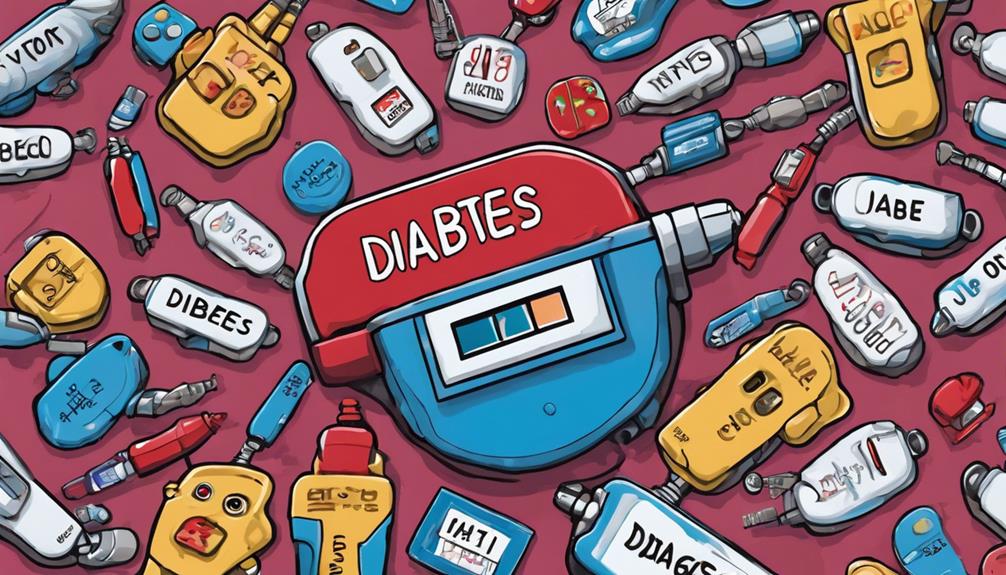Have you ever considered the potential of sea moss to revolutionize the management of diabetes?
The potential benefits of sea moss, stemming from its rich nutrient profile, have sparked interest in its role in supporting individuals with diabetes.
As we explore the relationship between sea moss and diabetes, it becomes evident that this seaweed's unique composition holds promise for enhancing various aspects of diabetic health.
But before we draw conclusions, let's unravel the science behind this intriguing connection and evaluate its practical implications for individuals navigating diabetes.
Key Takeaways
- Sea moss may stabilize blood sugar levels.
- Zinc in sea moss regulates insulin.
- Carrageenan slows glucose absorption.
- Sea moss improves insulin sensitivity.
Benefits of Sea Moss for Diabetics
Exploring the benefits of sea moss for diabetics reveals its potential in aiding blood sugar control and insulin resistance. Sea moss contains essential nutrients like zinc, which plays a crucial role in managing diabetes by helping to regulate insulin levels. The carrageenan found in sea moss is known to slow down glucose absorption in the body, thereby contributing to better blood sugar control. These properties make sea moss a valuable addition to the diet of individuals with diabetes.
Moreover, the vitamins and minerals present in sea moss exhibit anti-diabetic properties that can support overall diabetes management. Regular consumption of sea moss may help stabilize blood sugar levels, providing diabetics with a natural way to enhance their health. By incorporating sea moss into their diet, individuals with diabetes can potentially experience the benefits of improved insulin sensitivity and better glucose regulation, ultimately aiding in their journey towards managing diabetes effectively.
Impact on Blood Sugar Levels

Sea moss's impact on blood sugar levels is significant due to its high fiber content and the presence of carrageenan, a compound known to slow down glucose absorption in the body. Sea moss products, rich in fiber, help regulate blood glucose levels by slowing the rate at which sugar is released into the bloodstream. Additionally, the carrageenan found in sea moss plays a crucial role in managing blood sugar levels by inhibiting rapid spikes in glucose after meals.
| Sea Moss Benefits for Blood Sugar Levels | ||
|---|---|---|
| High Fiber Content | Carrageenan Presence | Zinc Content |
| Aids in stabilizing blood sugar levels | Slows glucose absorption | May prevent diabetes development |
| Beneficial for managing diabetes | Impacts blood glucose levels | Helps in preventing zinc deficiency |
For diabetes patients, incorporating sea moss into their diet can be beneficial in controlling blood sugar levels. The combined effects of fiber, carrageenan, and zinc make sea moss a valuable addition to meals for individuals striving to manage their blood sugar effectively.
Sea Moss and Insulin Sensitivity
In individuals with diabetes, sea moss's magnesium content may contribute to enhancing insulin sensitivity, potentially playing a role in improving blood sugar regulation. Magnesium is a crucial mineral that has been linked to insulin resistance, a common issue in diabetes. Sea moss, as a natural source of magnesium, can help address this deficiency and potentially improve insulin response in diabetic individuals.
By positively impacting insulin sensitivity, sea moss benefits may extend to better blood sugar management, making it a valuable addition to diabetes treatment strategies. Research suggests that sea moss consumption could play a role in lowering blood sugar levels and supporting overall diabetes management.
Therefore, incorporating sea moss into the diet of individuals with diabetes may offer a natural way to enhance insulin sensitivity and contribute to better regulation of blood sugar levels, ultimately aiding in diabetes control and treatment.
Incorporating Sea Moss Into Diabetic Diet

When considering the dietary management of diabetes, incorporating sea moss can offer potential benefits in blood sugar control and insulin sensitivity. Sea moss helps by providing essential nutrients like zinc, which plays a crucial role in managing diabetes by regulating insulin levels.
Additionally, the carrageenan found in sea moss can help slow down glucose absorption, aiding in maintaining stable blood sugar levels in diabetics. The iodine content in sea moss also contributes to its benefits for diabetes, as iodine is essential for thyroid function, which influences metabolism and can impact blood sugar regulation.
The vitamins and minerals present in sea moss have anti-diabetic properties that can support overall health and well-being in individuals managing diabetes. However, it's vital to consult with your healthcare provider before incorporating sea moss into your diabetic diet to ensure its safe and effective integration.
Risks and Considerations for Diabetics
Considering the potential interactions with medications and the risks associated with excess iodine intake, diabetics must approach the incorporation of sea moss into their diet cautiously and under professional guidance. Sea moss, while offering potential health benefits, can pose risks to individuals with diabetes due to its impact on blood glucose levels and thyroid function. Below is a table outlining key considerations for diabetics looking to include sea moss in their dietary regimen:
| Concerns | Impact on Diabetes | Recommendations |
|---|---|---|
| Medication Interactions | Alters insulin levels | Consult healthcare provider before use |
| Excess Iodine Intake | Disrupts thyroid health | Monitor iodine consumption carefully |
| Blood Glucose Levels | May affect sugar control | Regularly monitor glucose levels when consuming sea moss |
It is essential for diabetics to prioritize their health by understanding the potential risks associated with sea moss consumption and seeking professional advice to manage their condition effectively.
Frequently Asked Questions
Who Should Avoid Seamoss?
We should be cautious with sea moss if we have hyperthyroidism, allergies to seaweed or iodine, or are on blood-thinning medications. Consulting a healthcare provider is vital if we have iodine sensitivity, thyroid disorders, or if pregnant/breastfeeding.
Sea moss can pose risks due to its high iodine content. It's essential to prioritize our health and well-being by being informed about potential interactions and sensitivities related to consuming sea moss.
What Disease Does Sea Moss Help?
Sea moss, with its array of nutrients like zinc and magnesium, offers benefits beyond diabetes management. It aids in thyroid function, supports the immune system, and assists in weight loss.
The fucoxanthin present in sea moss improves insulin sensitivity and glucose metabolism. Its positive impact extends to regulating blood sugar levels.
Consistent consumption can provide various health advantages, making it a valuable addition to one's diet for overall well-being.
Is Seaweed OK for Diabetics?
Seaweed is generally considered safe for diabetics due to its low glycemic index. It can help regulate blood sugar levels, improve insulin sensitivity, and control blood sugar spikes with its fiber content.
Antioxidants in seaweed may reduce inflammation, benefiting overall health in diabetics. A nutrient-dense food, seaweed is a valuable addition to a diabetic-friendly diet.
What Are the Top 10 Benefits of Sea Moss?
We believe the top 10 benefits of sea moss include:
- Its high mineral content providing essential nutrients.
- Potential weight loss aid.
- Improved digestion.
- Lowered bad cholesterol levels.
Sea moss may also support:
- Thyroid function.
- Insulin production.
- Blood sugar control due to its iodine content and impact on insulin sensitivity.
Its fucoxanthin and alginate components can help regulate blood sugar levels and prevent spikes, making it a promising option for overall health.
Conclusion
In conclusion, sea moss can be a valuable addition to the diabetic diet, acting as a nutrient-rich ally in the battle against high blood sugar levels and insulin resistance.
Like a sturdy anchor in turbulent seas, sea moss offers stability and support for those navigating the challenges of diabetes.
By incorporating this powerful seaweed into their daily routine, individuals with diabetes may find a smoother journey towards better health and improved management of their condition.









